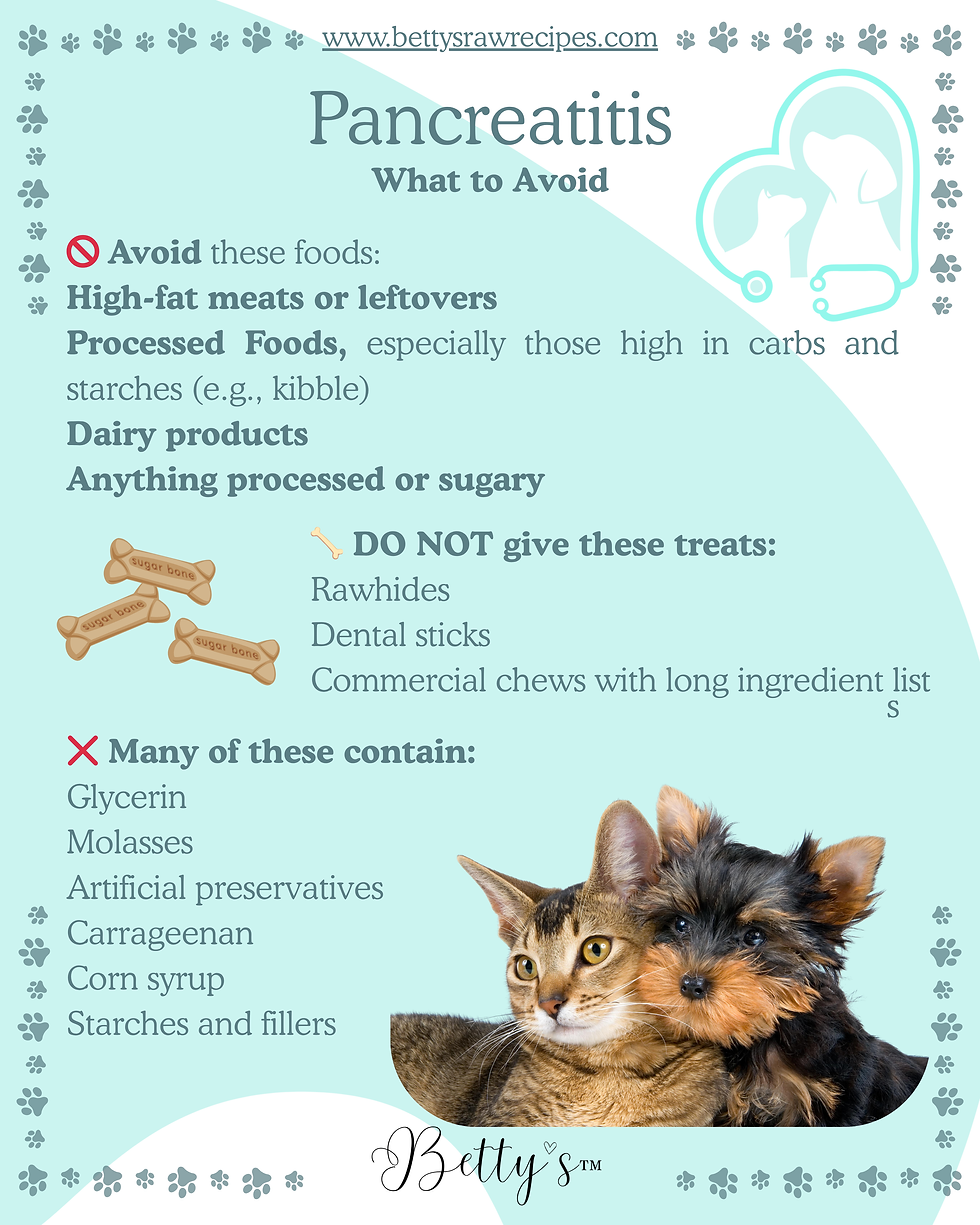Pancreatitis in Dogs & Cats: Causes, What to Avoid, and How to Support Recovery Through Nutrition
- Nicole Agius
- Jun 7
- 2 min read

Pancreatitis is one of the most common and concerning conditions in both dogs and cats. It can come on suddenly, with symptoms ranging from mild digestive upset to life-threatening inflammation. At Betty’s, we believe that nutrition plays a critical role in both prevention and healing — and that understanding what’s safe (and what’s not) is key to helping your pet recover.
🔬 What Is Pancreatitis?
Pancreatitis is the inflammation of the pancreas, a small but vital organ responsible for digesting food and regulating blood sugar. When inflamed, the pancreas can actually begin to digest itself.
Common Signs:
Abdominal pain (your pet may assume a “prayer position”)
Vomiting
Lethargy
Loss of appetite
Hunched back or discomfort
This condition can range from mild to severe, and early intervention is critical.
🧬 Why Does Pancreatitis Happen?
There are a number of contributing factors. Some are genetic, while others are dietary or environmental.
Common causes include:
Genetics (Miniature Schnauzers, Cavalier King Charles Spaniels, Shih Tzus, Yorkies, and some cats are more prone)
High-carb, high-fat, processed diets (especially kibble)
Fatty table scraps or leftovers
Underlying medical conditions: Cushing’s disease, hypothyroidism, diabetes, obesity
Medications: Corticosteroids, NSAIDs, painkillers
Surgical stress or trauma
Idiopathic (no known cause in some cases)

🚫 What Foods & Treats Should You Avoid?
Managing pancreatitis starts with eliminating the foods that can inflame the pancreas or disrupt digestion.
❌ Avoid:
High-fat meats (like beef or lamb)
Table scraps or fatty leftovers
Processed foods, especially dry kibble (high in starches like rice, oats, corn, or wheat)
Dairy products
Sugary or chemically preserved treats
⚠️ Treats to Skip:
Rawhides
Dental sticks
Long-ingredient commercial chews
These often contain:
Glycerin
Molasses
Carrageenan
Corn syrup
Artificial preservatives
Starches and fillers

🥣 What to Feed During & After a Flare-Up
🩺 During a Flare-Up:
Keep meals bland, small, and low in fat. We recommend:
Cooked turkey breast — lean, gentle, and easy to digest.
✅ Once Symptoms Settle:
Transition gradually to raw or gently cooked low-fat proteins. These are ideal:
🦃 Turkey:
Lean and cooling (according to Traditional Chinese Veterinary Medicine), and spleen-supportive.
🐇 Rabbit:
Low in fat and great for sensitive pets or those prone to allergies.
🐟 Cod:
White fish that’s easy on the digestive system and rich in natural omega-3s to help reduce inflammation.
At Betty’s, our whole food recipes are based on these proteins — because we believe in feeding pets foods that heal, not harm.
🦴 Treats That Support (Not Stress) the Pancreas
Only use single-ingredient treats, and offer in small amounts:
Dehydrated turkey breast
Air-dried or dehydrated cod skin
Avoid anything with additives, fillers, starches, or long ingredient lists.
💚 Our Philosophy at Betty’s
We know exactly what goes into our meals — because we make them from scratch using only whole, functional ingredients. Our focus is on:
Anti-inflammatory, low-fat proteins
No grains, starches, or synthetic additives
Transparency in every ingredient
_edited.png)







Comments